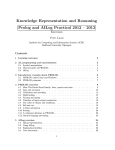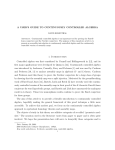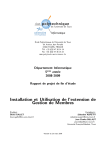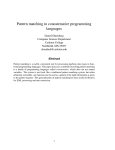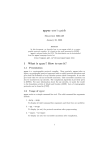Download SPEC 0.2: A User Manual
Transcript
SPEC 0.2: A User Manual
Alwen Tiu
Research School of Computer Science
The Australian National University
1
Overview
SPEC (for Spi-calculus Equivalence Checker) is an equivalence checker for a version of Abadi and Gordon’s spi-calculus [AG99]. The spi-calculus is an extension
of the π-calculus [MPW92], with operators encoding cryptographic primitives.
In this implementation, we consider only a symmetric key encryption. As shown
in [AG99], the spi-calculus can be used to encode security protocols, and via
a notion of observational equivalence, security properties such as secrecy and
authentication can be expressed and proved.
Intuitively, observational equivalence between two processes means that the
(observable) actions of the processess cannot be distinguished in any execution
environment (which may be hostile, e.g., if it represents an active attacker trying
to compromise the protocol). The formal definition of observational equivalence
[AG99] involves infinite quantification over all such execution environments and
is therefore not an effective definition that can be implemented. Several approximations have been proposed [AG98, BNP02, BBN04, BN05, Tiu07, Tiu09]; the
current implementation of SPEC is based on a notion of open bisimulation proposed in [Tiu07, Tiu09]. In particular, the decision procedure implemented here
derives from [TD10]. It is important to note that the notion of observational
equivalence as formalised in the spi-calculus assumes a model of intruder known
as the Dolev-Yao model [DY83]. This means, among others, that we assume
that the encryption function is perfect, in the sense that an attacker is not able
to decrypt an encrypted message unless he/she knows the key.
The current version of SPEC is still at the alpha testing phase, and allows only modeling symmetric encryptions. It is also not yet optimised for
performance. The tool can only reason about equivalence (or more precisely,
bisimilarities) of finite processes, i.e., those without recursion. It cannot yet be
realistically used to decide equivalence of protocols with unbounded sessions;
this will require more sophisticated techniques. In future releases, it is hoped
that more encryption operators will be supported and more functionalities will
be added, in particular, facilities to do (symbolic) trace analyses, correspondence
assertions, type checking and model checking.
The proof engine of SPEC is implemented in an improved version of the Bedwyr model checking system [BGM+ 07], but the user interface is implemented
1
directly in Ocaml, utilising a library of functions available from Bedwyr. The
user, however, does not need to be aware of the underlying Bedwyr implementation and syntax in order to use the tool.
Readers who are interested only in using SPEC for checking process equivalence should read Section 2, Section 3, Section 4 and Section 5. Section 6 and
Section 7 are intended for readers familiar with the Bedwyr system, and describe
various extensions to the Bedwyr system that are implemented to support the
proof engine of SPEC.
2
A quick start
2.1
Downloading and compiling SPEC
The latest version of SPEC can be downloaded from the project page:
http://users.cecs.anu.edu.au/~tiu/spec.
The SPEC distribution includes a modified version of the Bedwyr prover. SPEC
is implemented using the Ocaml language and has currently been tested only
on the Linux operating system.
To compile SPEC, download the SPEC package from the website given
above, and unpack it in a directory of your choice. For the purpose of this
tutorial, we assume that the unpacked files are located in the spec directory
inside the user’s home directory. The structure of the distribution consits of the
following directories:
• src/ : Contains the source codes for both the modified Bedwyr and SPEC
related files. The core engine of SPEC is located in the subdirectory
src/defs: these are program files that will be run in the Bedwyr proof
engine.
• doc/ : Contains the manual of SPEC.
• examples/ : Contains some examples of processess and protocols.
To compile the distribution, run the following commands:
# cd $HOME/spec
# ./configure
# make
This will create two executables: spec and bedwyr, in the subdirectory src/.
If you are not interested in tweaking the Bedwyr codes, the program spec is all
you need to be aware of.
Just as Bedwyr, by default, SPEC is built using the native-code Ocaml
compiler ocamlopt, since it is much faster. If for some reason this feature is not
desired, it can be disabled using ./configure --disable-native-code.
2
2.2
Running SPEC
To run the SPEC user interface, type
# src/spec
This will bring up the command line interface
SPEC: An equivalence checker for the spi-calculus.
Version 0.2
This software is under GNU Public License.
Copyright (c) 2011-2013 Alwen Tiu
SPEC>
At the command-line interface, we can define processes to be checked for equivalence. The precise syntax will be given in Section 3. Here is an example process
just as an illustration.
SPEC> P := nu (m, k). a< enc(m, k) >. [m = a] a<m>;
Reading spi definition
Here the symbol to the left of := is a process identifier, and the expression to
the right is the process itself. In this case, P is a process that creates two fresh
names, m and k, and output the encrypted message enc(m,k) (representing a
message that is obtained by encrypting m with key k) on channel a. It then
performs a (useless) check on whether m is equal to a (which is always false,
because m needs to be a fresh name), before outputting m on channel a.
Every definition (or any other statement) in the command prompt must ends
with a semicolon.
By default, SPEC treats free names in a process as public names, i.e., they
are known to the intruder. In this case, the only public name is a.
Let us define another process:
SPEC> Q := nu (k). a< enc(a, k) > ;
This process generates a fresh key k and encrypts the name a with k, and sends
it off on channel a.
Having defined the two processes, we can query SPEC to check whether they
are equivalent:
SPEC> bisim(P, Q);
Checking bisimilarity for:
nu(n1,n2).a<enc(n1,n2)>.[n1 = a]a<n1>.0
and
nu(n1).a<enc(a,n1)>.0
3
..
The two processes are bisimilar.
Size of bisimulation set: 2. Use #show_bisim to show the set.
Running time: + 0s
Note that the two processes are actually observationally equivalent, because
an attacker cannot distinguish the message output by P and that output by Q,
as the attacker does not have access to the key k (which is freshly generated).
Moreover, the guard [m = a] in P makes sure that the output action ahmi can
never be executed, so it is essentially equivalent to 0.
A ‘yes’ or ‘no’ answer may not be particularly convincing, especially if the
processes are large and complicated. SPEC provides a facility to produce an
evidence of the claimed equivalence, in the form of a bisimulation. To show such
a proof, use the following command:
SPEC> #show_bisim;
1.
Bitrace: []
First process: nu(n1,n2).a<enc(n1,n2)>.[n1 = a]a<n1>.0
Second process: nu(n1).a<enc(a,n1)>.0
2.
Bitrace: [(enc(n1,n2), enc(a,n2))^o.]
First process: [n1 = a]a<n1>.0
Second process: 0
SPEC>
In this case it is particularly simple. We’ll see the meaning of the output
in Section 5. There are also a couple of other forms of output, as we’ll see in
Section 5.
2.3
Available commands
There are some meta-commands available in SPEC, which can be queried by
using the #help command. The list of commands is as follows.
• #help: Display the help message.
• #exit: Exit the program.
• #equivariant: Turning the equivariant tabling on/off. See Section 7.1.
By default, equivariant is always set to on.
• #reflexive: Turning reflexivity checking on/off.
• #load [file]: Load a process definition file.
• #reset: Clears the current session. This removes all process definitions
defined in the current session.
4
• #show bisim: Displays the bisimulation set of the most recent bisimulation query.
• #save bisim [file]: Save the current bisimulation set to a file.
• #save bisim latex [file] : Save the current bisimulation set to a file
in the LaTeX format.
• #save bisim raw [file]: Save the current bisimulation set in the internal Bedwyr syntax.
• #show def [name]: Show the definition for an agent.
• #show defs: Show all the definitions.
• #time [on/off]: Show/hide the execution time of a query.
• #trace [on/off]: Enable/disable trace printing.
3
Syntax of processes
The spi-calculus generalises the π-calculus by allowing arbitrary terms to be
output, instead of just simple names. To define the language of processes, we
first need to define the set of terms (or messages). The set of terms allowed is
defined by the following grammar:
M, N ::= a | x | hM, N i | enc(M, N )
where a denotes a name and x denotes a variable. Names are considered to be
constants, i.e., they cannot be instantiated by other terms, wherease variables
can be instantiated. The need for variables arises from the need to symbolically
represent input values, which can range over an infinite set of messages, when
unfolding the transitions of a process. The message hM, N i represents a pair
of messages M and N , and enc(M, N ) represents a message M encrypted with
key N using a symmetric encryption function. Note that the key here can itself
be any term.
We assume a set of process identifiers, ranged over by capital letters such
as A,B,etc. The purpose of a process identifier is to simplify the writing of a
process, by acting as a sort of ‘macros’ for processes. A process identifier may
be assigned an arity, representing the number of arguments it accepts. The
language of processes is given by the following grammar:
P ::= A{a1 , . . . , an } | 0 | a(x).P | ahM i | [M = N ]P | ν(x1 , . . . , xm ).P |
(P | P ) | !P | let hx, yi = M in P | case M of enc(x, N ) in P.
The intuitive meaning of each of the process construct (except for process identifier, which is explained later) is as follow:
• 0 is a deadlocked process. It cannot perform any action.
5
• a(x).P is an input-prefixed process. The variable x is a binder whose scope
is P . The process accepts a value on channel a, binds it to the variable x
and evolves into P .
• ahM i.P is an output-prefixed process. It outputs a term M on channel a
and evolves into P .
• [M = N ]P is a process which behaves like P when M is syntactically
equal to N , but is otherwise a deadlocked process.
• ν(x1 , . . . , xm ).P is a process that creates m new names and behaves like
P . The ν operator (also called the restriction operator) binds the name
x1 , . . . , xm in P .
• P | Q is a paralel composition of P and Q.
• !P is a replicated process; it represents an infinite paralel copies of P .
• let hx, yi = M in P. The variables x and y are binders whose scope is P .
This process checks that M decomposes to a pair of messages, and binds
those messages to x and y, respectively.
• case M of enc(x, N ) in P. The variable x here is a binder whose scope
is P . This process checks that M is a message encrypted with key N ,
decrypts the encrypted message and binds it to x.
A process definition is a statement of the form:
A(x1 , . . . , xn ) := P
where A is a process identifier, of arity n, and P is a process. We call A(x1 , . . . , xn )
the head of the definition and P its body. The variables x1 , . . . , xn are the parameters of the definition. A process identifier that occurs in a process P must
be applied to arguments which are names. For example, if A is defined as:
A(x, y, z) := [z = y]zhxi.0
then it can be used in a process such as this:
a(x).a(y).a(z).A{x, y, z}.
This process is equivalent to
a(x).a(y).a(z).[z = y]zhxi.0
where the definition of A is expanded. SPEC does not allow recursive definitions,
so in particular, in the definition of a process identifer A, the same identifier
cannot occur in the body of the definition.
6
3.1
Concrete syntax
The concrete syntax accepted by the parser of SPEC is very similar to the
abstract one described previously. We follow the following conventions with
respect to names and identifiers:
• Names and variables are represented by any alpha-numeric strings that
start with a lower case letter, e.g., a, b, etc.
• Process identifiers are represented by any alpha-numeric strings that start
with a capital letter, e.g., A, B. We also allow the underscore ‘ ’ letter, e.g.,
as in Agent A.
The concrete syntax for each construct follows closely the abstract syntax given
previously, except for the ν operator which is represented by the keyword nu.
For example, the following processes
0
A{a, b, c}
a(x).[x = hb, ci]0
ν(x, y).ahxi.ahyi.0
!(ν(x).ahxi.0)
(A{a, b, c} | ahenc(b, k)i.0)
are respectively written in the concrete syntax as:
0
A{a,b,c}
a(x).[x = <b,c>]0
(A{a,b,c} | a<enc(b,k)>.0)
nu (x,y). a<x>.a<y>.0
!(nu (x).a<x>.0)
3.2
Operator precedence, associativity and simplication
To ease writing down (and reading) processes, we adopt the following conventions:
• All the unary operators, e.g., input/output prefix, the match operator,
the replication and the restriction operator, have higher precedence than
the parallel composition. For example, the expression
ν(x).ahxi.a(y).[x = y]0 | a(y).0
represents the process
(ν(x).ahxi.a(y).[x = y]0) | a(y).0.
• The paralel composition associates to the right. Thus (P | Q | R) is the
same as (P | (Q | R)).
• We can omit the trailing 0 in input/ouput prefixed processes. For example,
we write ahxi.a(y) instead of ahxi.a(y).0.
7
3.3
Inputing process definitions
As mentioned in Section 2, the definition of a process identifier can be entered
at the SPEC command prompt, by ending it with a semicolon. SPEC checks
whether all free names in the body of the definition are in the parameters of the
definition. If there is a name in the body which does not occur as a parameter,
SPEC gives a warning.
Process definitions can also be imported from a file. To do so, simply write
down the definitions in a file, with each definition ended with a semicolon.
To load the definition, use #load. For example, the following loads the file
wideMouthedFrog.spi in the examples subdirectory.
SPEC> #load "examples/wideMouthedFrog.spi";
8 process definition(s) read. Use #show_defs to show all definitions
SPEC>
The definition of a particular process identifier can be queried using the command #show def, followed by the identifier. For example:
SPEC> #show_def P;
P := nu(n1,n2).a<enc(n1,n2)>.[n1 = a]a<n1>.0
SPEC>
The command #show defs will show all the definitions entered so far.
4
Some theoretical backgrounds
This section is intended to provide a very brief account of the notion of bisimulation used in SPEC in order to understand its output. For a more detailed
account, the reader is refered to [Tiu07, Tiu09].
The procedure to prove observational equivalence implemented by SPEC is
based on a notion strong open bisimulation for the spi-calculus developed in
[Tiu07]. Open bisimulation is sound with respect to observational equivalence,
in the sense that when two processes are open bisimilar, they are also observationally equivalence. However, it is not complete, as there are observationally
equivalent processes that cannot be proved using open bisimulation. This is not
specific to our notion of bisimulation, rather it is a feature of strong bisimulation
which do not abstract away from internal (unobservable) transitions. For example, the process ν(x).(xhai | x(y).ahbi) and the process ahbi are observationally
equivalent, but are not strongly bisimilar.
A bisimulation is essentially a set that satisfies some closure conditions. We
shall not explain in details what those conditions are; these can be found in
[Tiu09, TD10]. Instead, we shall only illustrate what the members of such a
bisimulation look like. Our notion of bisimulation is parametric on a structure
which we call bitraces. A bitrace represents a history of the (input/output)
actions of the pair of processes being checked for bisimilarity. A bitrace is
essentially a list of i/o pairs. An i/o pair is either an input pair, written (M, N )i ,
8
where M and N are messages, or an output pair, written (M, N )o . We write
a bitrace by separating the i/o pairs with a ‘.’ (‘dot’). For example, here’s a
bitrace:
(a, b)o .(x, x)i .(enc(x, a), enc(x, b))o .
Recall our convention that a and b are names, whereas x is a variable, representing unknown values. Implicitly, the ordering of elements of the bitrace
represents a ‘timestamp’ of the message pairs. In this case, the pair of processes
first output, respectively, a and b, and then input (an unspecified) x, before
outputing, respectively, enc(x, a) and enc(x, b). The empty bitrace is denoted
by [ ].
A bitrace can be seen as a pair of symbolic traces, where the input values
can be left unspecified. Bitraces are subject to certain well-formedness criteria,
which can be found in [Tiu09]. The essence of those criteria is that the two
symbolic traces that the bitrace represent are observationally indistinguishable
from the view point of an intruder. The technical definition of observationally
indistinguishability of traces is a bit complicated, but here is a simplified account. When an intruder observes a (symbolic) trace, what he is observing is
not the identity of a particular message or messages, but rather what sorts of
operations one can do with them. For example, in a sequence of messages (or a
trace) such as:
k.enc(m, k).m
(following bitrace notations, we use dots to separate individual messages), what
the intruder observes is that he can use the first message in the sequence to
decrypt the second message and obtain a message that is identical to the third
message in the sequence. Here the particular names used in the message is
unimportant, as long as he could do those two operations of decryption and
message comparison. So from this perspective, the intruder would consider the
following sequence of messages observationally equivalent to the previous one:
l.enc(n, l).n
despite the fact that we use different names. However, the intruder will be able
to detect a difference with the following trace (assuming m and n are distinct
names):
l.enc(n, l).m
as the intruder notices that the result of decrypting the second message with
the first message as the key produces a different message than the third one.
More specifically, the observational capabilities of an intruder, as formalised
in [AG98], can be summarised as follows:
• Decryption: the ability to decrypt an encrypted message given the right
key.
• Projection: the ability to extract components of a pair.
• Equality testing: the ability to compare two messages for syntactic equality.
9
For the purpose of simplifying the implementation of SPEC, we assume an
additional capability: we assume that the intruder has knowledge of a set of
“public” names (as in the notion of frames in Abadi and Gordon’s frame bisimulation [AG98]). That is, we shall designate a certain set of names to be public
names. We shall simply call these names constants. Hence the intruder also
possesses the following capability:
• Constant testing: the ability to recognise a constant.
In the user interface of SPEC, any free names entered by the user are considered
constants. The purpose of introducing constants as public names is to reduce
the size of bitraces when checking for equivalence, as these constants need not
be included in the bitraces.
A consistent bitrace is then a bitrace where all possible observations applying
to its first projection are also valid observations on its second projection, and
vice versa. This is related to the notion of static equivalence in the applied-pi
calculus [AF01], where a bitrace can be seen as a pair of statically equivalent
frames [AF01].
A bisimulation is a set of triples of the form (h, P, Q) where h is a consistent bitrace, and P and Q are processes, satisfying some closure conditions
(see [Tiu09]). Two processes P and Q are observationally equivalent (or, more
precisely, bisimilar) if we can exhibit a bisimulation set containing the triple
([ ], P, Q).
5
Checking process equivalence and understanding its outputs
Let us start by defining a couple of simple processes.
SPEC> P := nu (x,y). a< enc(x,y) >.a<b> ;
SPEC> Q := nu (x,y). a< enc(b,y) >.a<b> ;
This defines two processes P and Q. We can use the command #show defs to
show the process definitions we entered so far:
SPEC> #show_defs;
P := nu(n1,n2).a<enc(n1,n2)>.a<b>.0
Q := nu(n1,n2).a<enc(b,n2)>.a<b>.0
SPEC>
Notice that SPEC automatically renames the bound variables x and y to its
internally generated fresh names (n1 and n2 in this case). In general, SPEC
will prefix any bound names or names freshly generated with the letter ‘n’. The
engine also performs α-conversion as neccessary to avoid name clashes.
As discussed in the previous section, free names in a process entered by the
user are automatically considered as constants by SPEC, with the consequence
that they are known publicly to the intruder.
10
Recall from Section 2 that the command bisim allows use to check for bisimilarity:
SPEC> bisim(P,Q);
Checking bisimilarity for:
nu(n1,n2).a<enc(n1,n2)>.a<b>.0
and
nu(n1,n2).a<enc(b,n2)>.a<b>.0
..
The two processes are bisimilar.
Size of bisimulation set: 2. Use #show_bisim to show the set.
Running time: + 0s
What the implementation of bisimulation in SPEC does is basically unfold
the transitions of P and Q in locked steps, and at each step, the messages
input/output by the processes are added to the current bitrace (initially, it is
the empty bitrace). At each step, SPEC also checks that the bitrace produced
in that step is consistent. The bisimulation set produced by SPEC can be
displayed using #show bisim:
SPEC> #show_bisim;
1.
Bitrace: []
First process: nu(n1,n2).a<enc(n1,n2)>.a<b>.0
Second process: nu(n1,n2).a<enc(b,n2)>.a<b>.0
2.
Bitrace: [(enc(n1,n2), enc(b,n2))^o.]
First process: a<b>.0
Second process: a<b>.0
SPEC>
The original processes are listed in the first item, which get unfolded into the
second item. In the second item, we notice that the first process is actually
equal to the second process. SPEC recognises this automatically and stops the
unfolding at this point, as bisimilarity is reflexive. The resulting bitrace at each
step is also given. As we said earlier, input or output messages are appended to
the current bitrace at each step.
5.1
Separation of names in bisimulation
An important thing to note in reading a bisimulation triple (h, P, Q) is that the
names (other than constants) used in the first projection of the bitrace h and
process P are unrelated to the names used in the second projection of h and Q.
This is because names represent entities that may be generated internally by
the processes (via scope extrusion) and may be unknown to the intruder, hence
their identities are not something which is generally observable. See [AG98] for
an explaination of this.
11
5.2
Equivariance of bisimilarity
Another important thing to keep in mind when reading the output bisimulation
set produced by SPEC is that each triple in the set represents an equivalence
class of triples modulo renaming of variables and names (but excluding constants). Thus, a triple such as
([(x, x)i .(enc(n, m1 ), enc(b, m2 ))o ], P, Q)
where x is a variable, n and m are non-constant names and b is a constant,
represents the set containing
([(xθ, xθ)i .(enc(nθ, m1 θ), enc(b, m2 θ))o ], P θ, Qθ)
where θ is an renaming substitution.
5.3
Examples
We show here a simple but interesting example to illustrate features of the
bisimulation output. The SPEC distribution contains a number of small and big
examples in the directory examples. Some of these examples encode a number
of security protocols. These examples may produce very large bisimulation sets
(in the order of hundreds to more than a thousand elements) and may take quite
a while to execute.
Example 1 Let
P 1 := a(x).ν(k).ahenc(x, k)i.ν(m).ahenc(m, enc(a, k))i.mhai
Q1 := a(x).ν(k).ahenc(x, k)i.ν(m).ahenc(m, enc(a, k))i.[x = a]mhai
The process P 1 inputs a term via channel a, binds it to x and output an encrypted message enc(x, k). It then generates a new channel m, sends it off
encrypted with the key enc(a, k). Here the name a is a constant, so it is known
to the intruder. The process then sends a message on the newly generated
channel m. Although the channel m is a secret generated by P 1, and it is not
explicitly extruded, the intruder can still interact via m if it feeds the name a
to P 1 (hence binds x to a). As a result, the (symbolic) output enc(x, k) can
be ‘concretized’ to enc(a, k), which can be used to decrypt enc(m, enc(a, k)) to
obtain m.
The process Q1 is very similar, except that it puts a ‘guard’ on the possibility
of interacting on m by insisting that x = a. The above informal reasoning about
the behavior of P 1 shows that it should be observationally equivalent to Q1.
Before we try proving the bisimilarity of P 1 and Q1, first execute the following command:
SPEC>#reflexive off;
Reflexivity checking is disabled.
12
This instructs SPEC to disable an optimisation, i.e., the reflexivity checking.
Reflexivity checking allows SPEC to conclude immediately that identical pairs
of processes are bisimilar. Disabling this allows us to see a bit more clearly how
the bitraces in the bisimulation set in the following example change from one
entry to another.
After disabling reflexivity checking and running the command bisim(P1,Q1),
we get that the two processes are indeed bisimilar. The bisimulation set produced can be displayed using the #show bisim command, but here we shall try
to output it in a LaTeX format:
1. Bi-trace: [ ]
First process:
a(n1).
ν (n2).
a h enc(n1, n2) i.
ν (n3).
a h enc(n3, enc(a, n2)) i.
n3 h a i.
0
Second process:
a(n1).
ν (n2).
a h enc(n1, n2) i.
ν (n3).
a h enc(n3, enc(a, n2)) i.
[n1 = a]
n3 h a i.
0
2. Bi-trace:
(enc(a, n1) , enc(a, n1))o .
(enc(n2, enc(a, n1)) , enc(n2, enc(a, n1)))o .
First process:
0
Second process:
0
13
3. Bi-trace:
(?n1 , ?n1)i .
First process:
ν (n2).
a h enc(?n1, n2) i.
ν (n3).
a h enc(n3, enc(a, n2)) i.
n3 h a i.
0
Second process:
ν (n2).
a h enc(?n1, n2) i.
ν (n3).
a h enc(n3, enc(a, n2)) i.
[?n1 = a]
n3 h a i.
0
4. Bi-trace:
(?n1 , ?n1)i .
(enc(?n1, n2) , enc(?n1, n2))o .
First process:
ν (n3).
a h enc(n3, enc(a, n2)) i.
n3 h a i.
0
Second process:
ν (n3).
a h enc(n3, enc(a, n2)) i.
[?n1 = a]
n3 h a i.
0
14
5. Bi-trace:
(?n1 , ?n1)i .
(enc(?n1, n2) , enc(?n1, n2))o .
(enc(n3, enc(a, n2)) , enc(n3, enc(a, n2)))o .
First process:
n3 h a i.
0
Second process:
[?n1 = a]
n3 h a i.
0
A few notes on the output produced by SPEC:
• Typesetting of names and variables: Variables are typeset by prepending
the variables with a question mark ‘?’. Bound names and non-constant
names are typeset using italised fonts, while constants are un-italicised.
• The original process pair is given in item 1. The unfolding sequence proceeds as follows: 1 → 3 → 4 → 5 → 1. Notice that in moving from 5 to 1,
the input pair disappears from the bitrace. This is because the variable
?n1 gets instantiated to a, which is a constant (hence, public knowledge),
and it is removed by the simplification step of SPEC.
• Equivariance of bisimulation: Notice that in proceeding from 5 to 1 there is
an implicit renaming performed by SPEC.1 Without renaming, the bitrace
in item 1 would have been the following:
(enc(a, n2) , enc(a, n2))o .
(enc(n3, enc(a, n2)) , enc(n3, enc(a, n2)))o .
6
Interacting at the Bedwyr level
This section is intended only for readers familiar with the Bedwyr system. Please
refer to the Bedwyr website (http: // slimmer. gforge. inria. fr/ bedwyr/ )
for an introduction to the Bedwyr system.
The SPEC proof engine is implemented on top of a modified version of Bedwyr. The Bedwyr codes for SPEC are contained in the subdirectory src/defs.
Here is a brief description of the important definition files in that directory:
1 This automatic renaming is a built-in feature of Bedwyr, so it is not possible to alter it
without modifiying the search engine of Bedwyr. It is a by-product of equivariance tabling
implemented in Bedwyr. See Section 7.
15
• bisim.def: This is the main module that implements the bisimulation
checking.
• bitrace.def: This module implements procedures related to bitraces, in
particular, the decision procedure for checking bitrace consistency.
• intruder.def: This module implements a decision procedure for solving
deducibility constraints, under the Dolev-Yao intruder model. It is used
in the decision procedure for bitrace consistency.
• spi.def: This module implements the operational semantics of the spicalculus.
6.1
Intermediate syntax of processes
The theoretical foundation of Bedwyr is based on a variant of Church’s simple
theory of types. All expressions in Bedwyr are encoded as simply typed λ-terms.
For the implementation of SPEC, we introduce (among others) the following
types for the syntactic categories of terms and processes:
• name: the set of ‘unsorted’ names. Spi-calculus names, constants and
variables are encoded using additonal unary operators applied to these
unsorted names.
• tm: the set of terms (i.e., messages). Constructors for terms are as follows:
– ct : name → tm. This is used ot encode constant.
– var : name → tm. This is used to encode variables.
– nm : name → tm. This is used to encode names (other than constants).
– pr : tm → tm → tm. This encodes pairing.
– enc : tm → tm → tm. This encodes symmetric encryption.
• proc: this is the type of processes. Constructors for processes are as
follows:
– zero : proc. The 0 process.
– par : proc → proc → proc. Parallel composition.
– nu : (tm → proc) → proc. Restriction.
– match : tm → tm → proc → proc. Matching.
– inp : tm → (tm → proc) → proc. Input prefix.
– outp : tm → tm → proc → proc. Output prefix.
– let : tm → (tm → tm → proc) → proc. Let-operator.
– case : tm → tm → (tm → proc) → proc. Case-operator.
– bang : proc → proc. Replication.
16
For example, the process ν(y).(a(x).[x = y]0 | ahyi.0) will be represented as the
simply-typed term (assuming we have a term a of type name):
nu λy.(par (inp (ct a) (λx.match x y zero)) (outp (ct a) y zero)).
Note that the nu operator binds only one name at a time, so to encode multiple
binders such as ν(x, y).[x = y]0, we iterate the nu operator twice, i.e.,
nu λx.(nu λy.match x y zero).
6.2
Running the bisimulation checker
To main procedure for checking bisimilarity is located in the file src/defs/bisim.def.
We first invoke Bedwyr and load this file:
# src/bedwyr src/defs/bisim.def
Bedwyr 1.4-alpha2 (revision 861) welcomes you.
This software is under GNU Public License.
Copyright (C) 2005-2012 Slimmer project.
For a little help, type "#help."
?=
The predicate for bisimulation checking is called bisim, and it takes three arguments: the first one is for bitrace, and the second and the third are processes
we want to check equivalence for.
A bitrace is represented as a list of i/o pairs in Bedwyr. The type bt pair
denotes the set of i/o pairs, and it has the following constructors:
• in : tm → tm → bt pair, used to encode input pairs, and
• out : tm → tm → bt pair, used to encode output pairs.
Lists are encoded using the standard polymorphic constructors: nil for the
empty list and cons for constructing a new list given an element and another
list.
What the SPEC interface does when checking bisimilarity is basically calling
the bisim predicate with the empty list as the bitrace. For example, for checking
bisimilarity of ν(m, k).ahenc(m, k)i.0 and ν(k).ahenc(a, k)i.0, one would type
the following query:
?= nabla a\ bisim nil (nu m\ nu k\ outp (ct a) (en m k) zero)
(nu k\ outp (ct a) (en (ct a) k) zero).
..Yes.
More [y] ?
17
The ∇ quantifier provides a new name. Here we assume that a is a constant.
Working directly in Bedwyr allows us to enter a more flexible query, such
as attaching a non-trivial bitrace to the bisimulation pair. For this, we shall
utilise the predicate toplevel bisim. This predicate works as bisim, except
it also checks the bitrace for consistency, whereas bisim does not check for
consistency. For example, instead of assuming a as constant, we could assume
it is a (non-constant) name, using the constructor nm. We will need to add this
name explicitly in the bitrace, otherwise the bisimulation checker will reject it.
?= nabla a\ toplevel_bisim
(cons (out (nm a) (nm a)) nil)
(nu m\ nu k\ outp (nm a) (en m k) zero)
(nu k\ outp (nm a) (en (nm a) k) zero).
..Yes.
More [y] ?
6.3
Bisimulation output in Bedwyr syntax
The predicate bisim is declared as a coinductive predicate in bisim.def. This
means that Bedwyr automatically saves successful or failed proof search associated with the bisim predicate in a table. The set of bisimulation associated
with the current bisimulation query can be displayed using the #show table
command. For example, continuing the previous example, one can display the
entries of the table as follows.
?= #show_table bisim.
Table for bisim contains (P=Proved, D=Disproved):
[P] (nabla (x1\
nabla (x2\
nabla (x3\
bisim (cons (out (nm x3) (nm x3))
(cons (out (en (nm x2) (nm x1))
(en (nm x3) (nm x2)))
nil))
zero zero))))
[P] (nabla (x1\
bisim (cons (out (nm x1) (nm x1)) nil)
(nu (x2\ nu (x3\ outp (nm x1) (en x2 x3) zero)))
(nu (x2\ outp (nm x1) (en (nm x1) x2) zero))))
[D] (nabla (x1\
bisim (cons (out (nm x1) (nm x1)) nil)
(nu (x2\ nu (x3\ outp (ct x1) (en x2 x3) zero)))
(nu (x2\ outp (nm x1) (en (ct x1) x2) zero))))
?=
The bisimulation set consists of those entries marked with [P]. Notice that the
names in the entries of the table are ∇-quantified. This reflects the fact that
the bisimulation set is closed under renaming.
18
Note that in the SPEC interface, one can also output the bisimulation set
in the Bedwyr syntax using the command #save bisim raw.
7
Extensions to Bedwyr
This section is intended only for readers familiar with the Bedwyr system. Please
refer to the Bedwyr website (http: // slimmer. gforge. inria. fr/ bedwyr/ )
for an introduction to the Bedwyr system.
The Bedwyr version used to implement SPEC is a modification of the official
release of Bedwyr. The reason for this modification is mainly because that the
decision procedure for checking bitrace consistency needs to manipulate substitutions of the object-level (i.e., spi-calculus) variables explicitly and perform
unification on them. The implementation encodes object-level variables and
names as rigid terms in Bedwyr, but dynamically convert these to logic variables and back in order to access the built-in unification procedure of Bedwyr.
As a consequence, some of the modifications to Bedwyr introduce non-logical
features that allow abstracting away logic variables. The logical interpretations of these additional features are currently unclear, so the implementation
of SPEC in this modified Bedwyr does not inherit the meta-logical properties of
the logic underlying Bedwyr [BGM+ 07]. It is therefore more appropriate to view
this modified Bedwyr as a programming framework rather than a proper logical framework like it was designed to be. However, as the bisimulation checker
in SPEC can actually output a bisimulation set as a witness of observational
equivalence, unsoundness of Bedwyr is not a real concern as that witness can
be checked for correctness independently of the Bedwyr engine.
The list of non-logical predicates added to Bedwyr is given below. All these
are prefixed with an underscore ( ).
• not : o → o. This is the standard negation-as-failure as in prolog.
• if: o → o → o → o. This is an if-then-else operator. The query
( if P Q R) is basically equivalent to (P ∧ Q) ∨ ( not(P ) ∧ Q). The
slight difference is that the second disjunct will not be tried if the query
P succeeds.
• distinct: o → o. Calling ( distinct P ) directs bedwyr to produce only
distinct answer substitutions. For example, if a predicate p is defined as
follows:
p a.
p a.
then querying p X in Bedwyr will answer with the same answer substitution twice.
?= p X.
19
Solution found:
X = a
More [y] ? y
Solution found:
X = a
More [y] ? y
No more solutions.
?=
If we apply the distinct operator, only one answer substitution is given.
?= _distinct (p X).
Solution found:
X = a
More [y] ? y
No more solutions.
?=
• abstract : α → (β → α) → α → o. Here α and β can be any types.
A query like ( abstract T Abs T’) abstracts the logic variables in T of
type β, and apply the constructor Abs to each abstraction, and unify the
result with T’. For example:
?= _abstract (pr X Y) abs T.
Solution found:
X = X
Y = Y
T = (abs (x1\ abs (x2\ pr x1 x2)))
More [y] ? y
No more solutions.
Note that because abstract can abstract any logic variables, and because
the underlying proof search engine of Bedwyr is untyped, the abstraction
produced by abstract may not always respect the type of the constructor
abs. For example, consider the above example. If pr is of type α → β →
α, for some distinct types α and β, and abs is of type α → α, then the
above query will still succeed despite the fact that abs is applied to terms
of both types. Hence type checking at the user level does not guarantee
runtime type soundness (‘well typed programs don’t go wrong’). In the
future, we plan to integrate type checking directly into the Bedwyr engine,
so that it only abstracts variables of the correct types.
• rigid : α → o. This is a meta-level assertion predicate. The query
( rigid X) will throw an exception (hence causes the prover to abort) if
X is not a ground term. This predicate is mainly used as an assertion in
SPEC prover to ensure that no (logic) variable leaks occur when converting
an object variable to a logic variable and vice versa.
20
• trace: o. This nullary predicate returns the value of the trace flag set via
the #trace command (see below). It can be used by programs to toggle
on/off printing of traces or other debugging information.
• abort: o. This predicate aborts the proof search and returns to the
toplevel query (if in interactive mode).
Two new system-level commands have been introduced:
• #trace <on/off>: This system-level command sets the trace flag. Note:
the system only sets the flag to true/false. The use of this flag is up to the
program. Its value can be read off by a program via the predicate trace.
• #save table <predicate> <filename>: This will save the table for a
predicate to a definition file. A proved entry will become the argument
of a predicate called ‘proved’. Similarly, an unproved entry will be the
argument of an ‘unproved’ predicate.
7.1
Modifications to the tabling mechanism
The tabling mechanism now allows for matching of table entries up to renaming
of ∇-variables. As an example, consider this very simple program:
inductive q X Y := println "Proved without using table".
and consider this query:
?= nabla x\ nabla y\ q x y.
Proved without using table
Yes.
More [y] ? n
Bedwyr executes the body of the definition clause for q, which prints a message,
and stores the goal in the table. Now, the second time the query is repeated:
?= nabla x\ nabla y\ q x y.
Yes.
More [y] ?
we see that the print statement is not executed, because Bedwyr proves the
query by a lookup in the table of previously proved queries and does not execute
the body of the clause. To see the effect of automatic renaming, consider this
query:
?= nabla x\ nabla y\ q y x.
Yes.
More [y] ?
where the roles of x and y are exchanged. This query is also executed successfully
by a table lookup, as the goal can be matched to the table entry by renaming y to
x. We see that adding vacuous ∇-quantification does not affect this equivariant
matching, as in the following query:
21
?= nabla x\ nabla y\ nabla z\ q x z.
Yes.
More [y] ?
What the tabling lookup checks is that q has two distinct ∇-variables as arguments. So the following query will not match the table (as a consequence, the
message in the body of the clause will again be printed):
?= nabla x\ q x x.
Proved without using table
Yes.
More [y] ?
Acknowledgment
This work is supported by the ARC Discovery grants DP0880549 and DP110103173.
The author would like to thank David Baelde for many useful correspondences
regarding the implementation of the Bedwyr system, and Quentin Heath for
many improvements to the Bedwyr proof engine used to implement SPEC.
References
[AF01]
Mart´ın Abadi and C´edric Fournet. Mobile values, new names, and
secure communication. In POPL, pages 104–115, 2001.
[AG98]
Mart´ın Abadi and Andrew D. Gordon. A bisimulation method for
cryptographic protocols. Nord. J. Comput., 5(4):267–303, 1998.
[AG99]
Martin Abadi and Andrew D. Gordon. A calculus for cryptographic protocols: The spi calculus. Information and Computation,
148(1):1–70, 1999.
[BBN04]
Johannes Borgstr¨om, S´ebastien Briais, and Uwe Nestmann. Symbolic bisimulation in the spi calculus. In Philippa Gardner and
Nobuko Yoshida, editors, CONCUR, volume 3170 of Lecture Notes
in Computer Science, pages 161–176. Springer, 2004.
[BGM+ 07] David Baelde, Andrew Gacek, Dale Miller, Gopalan Nadathur, and
Alwen Tiu. The Bedwyr system for model checking over syntactic
expressions. In Frank Pfenning, editor, 21th Conference on Automated Deduction, number 4603 in LNAI, pages 391–397. Springer,
2007.
[BN05]
Johannes Borgstr¨om and Uwe Nestmann. On bisimulations for
the spi calculus. Mathematical Structures in Computer Science,
15(3):487–552, 2005.
22
[BNP02]
Michele Boreale, Rocco De Nicola, and Rosario Pugliese. Proof
techniques for cryptographic processes. SIAM Journal of Computing, 31(3):947–986, 2002.
[DY83]
D. Dolev and A. Yao. On the security of public-key protocols. IEEE
Transactions on Information Theory, 2(29), 1983.
[MPW92] Robin Milner, Joachim Parrow, and David Walker. A calculus of
mobile processes, Part II. Information and Computation, pages 41–
77, 1992.
[TD10]
Alwen Tiu and Jeremy E. Dawson. Automating open bisimulation
checking for the spi calculus. In Proceedings of the 23rd IEEE Computer Security Foundations Symposium (CSF 2010), pages 307–321.
IEEE Computer Society, 2010.
[Tiu07]
Alwen Tiu. A trace based bisimulation for the spi calculus: An
extended abstract. In APLAS, volume 4807 of Lecture Notes in
Computer Science, pages 367–382. Springer, 2007.
[Tiu09]
Alwen Tiu. A trace based bisimulation for the spi calculus. CoRR,
abs/0901.2166, 2009.
23























